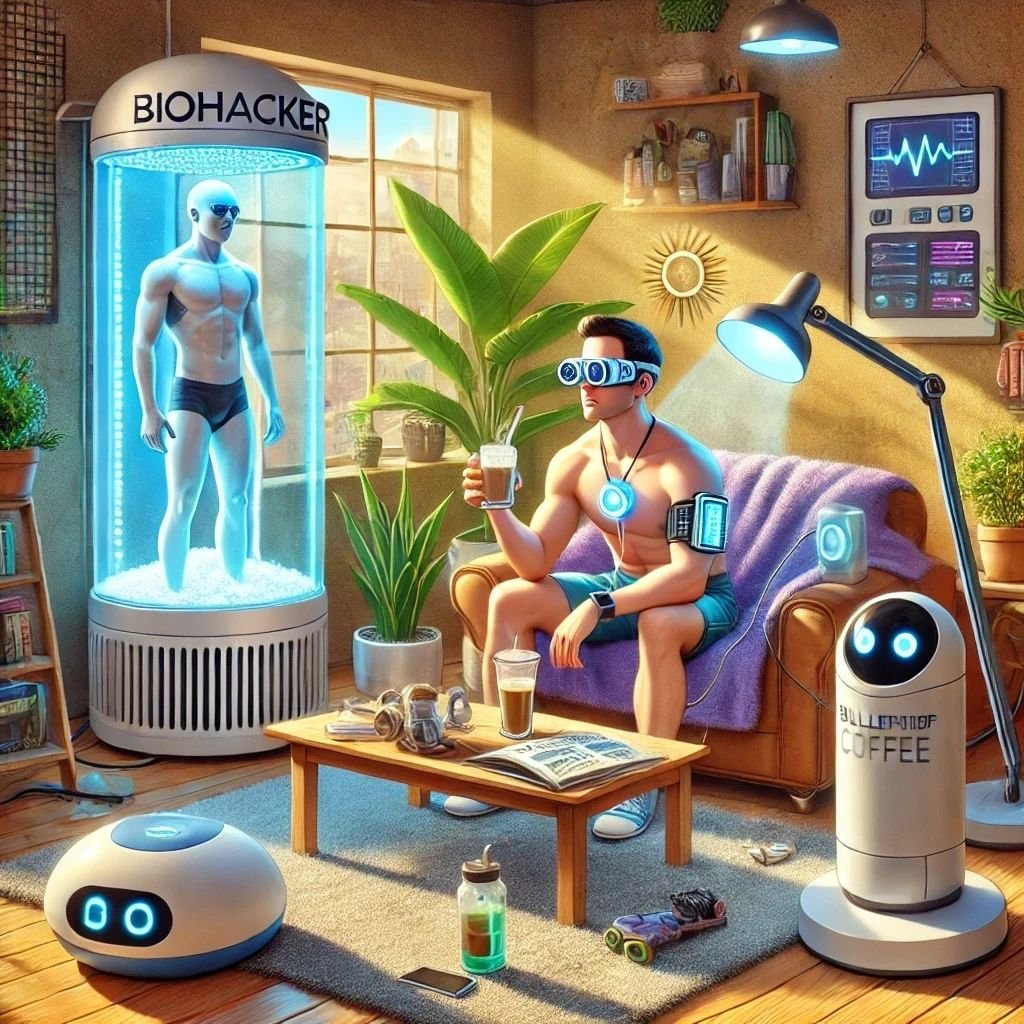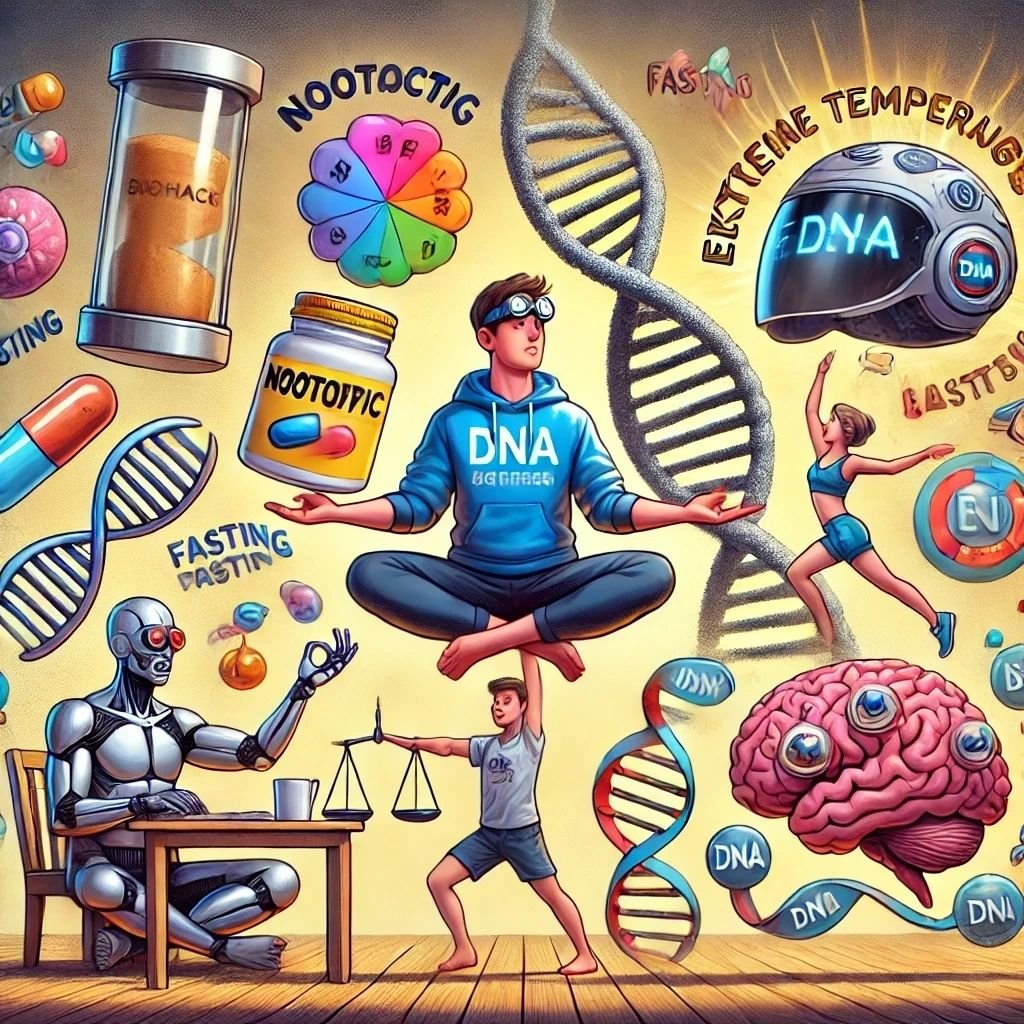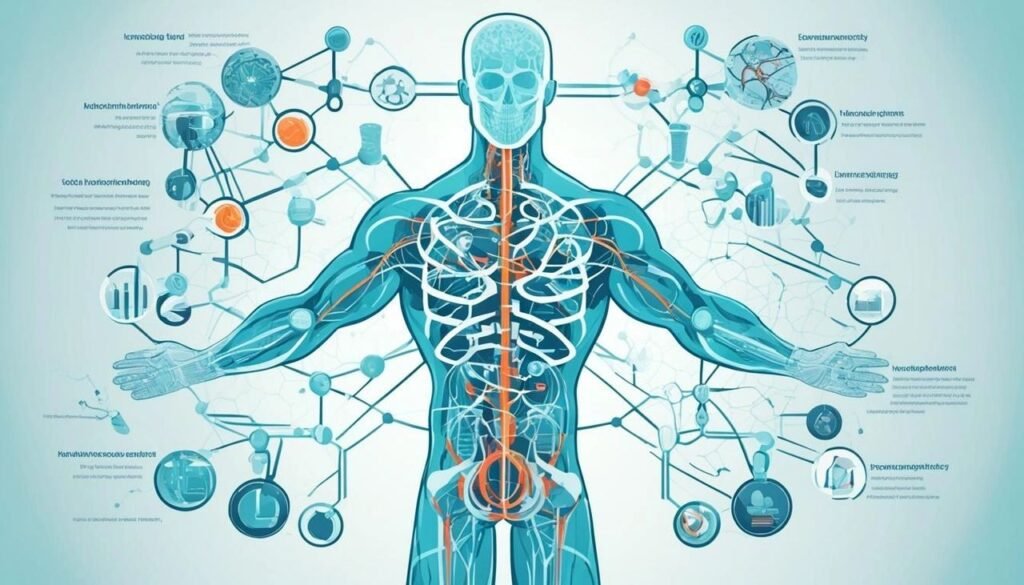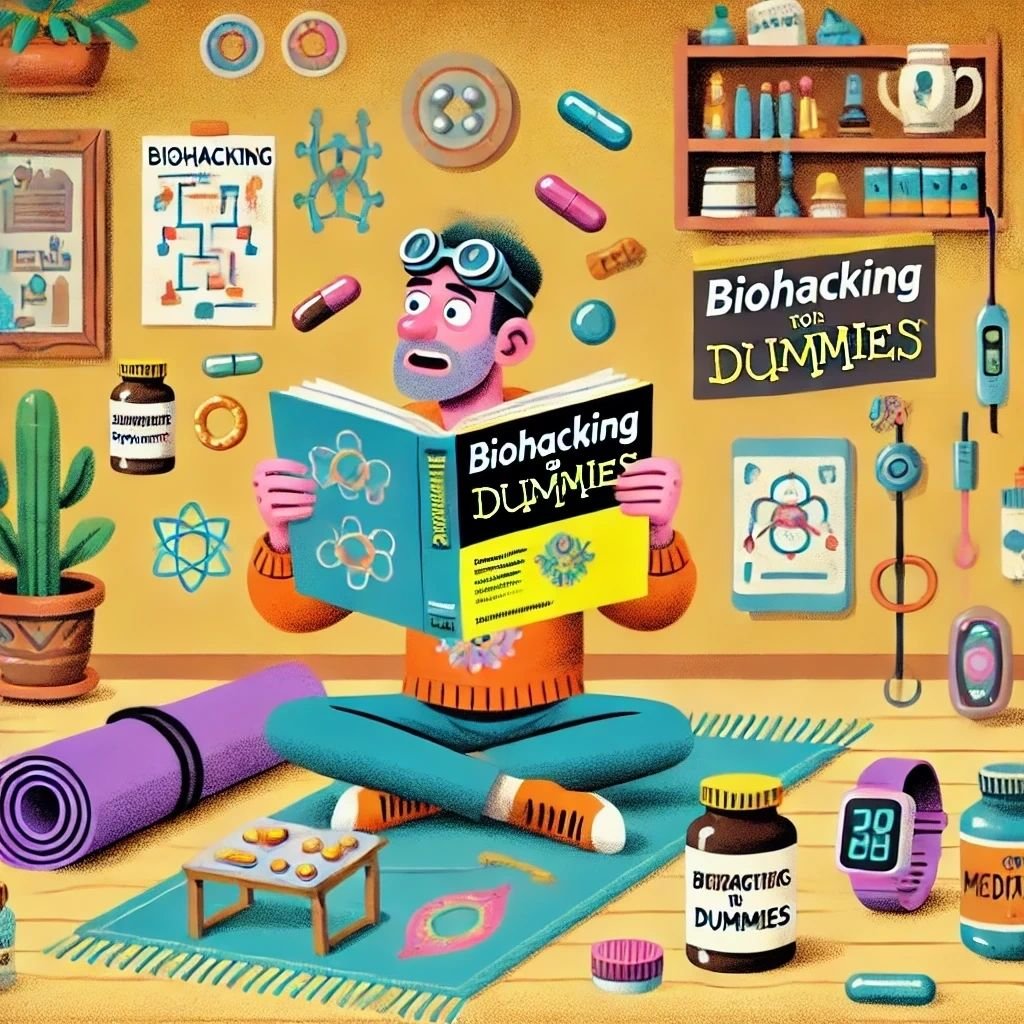Hello friends,
I’m sure this won’t be the last article I publish on biohacking and hacking your body. I’m sure by now you’ll all have heard of this growing trend. If biohacking was a business (and arguably it’s growing into one), you could define it as just exiting start up phase and getting ready to go main stream. I figured Biohacking for Beginners will be useful and at least allow you to become acquainted with this fringe, exciting and sometimes downright bizarre subject.
Ever pondered the possibility of controlling your biology to boost your physical and mental performance? This guide is your gateway to the world of self-optimisation through biohacking. It’s designed to equip you with the knowledge to enhance your well-being using both budget-friendly and sophisticated techniques. You’ll learn what biohacking entails and the key resources needed for this transformative journey.
Biohacking is more than just new methods; it’s a growing culture that makes you rethink your health. This guide will show you how to take charge and improve your body’s potential. With DIY projects and advanced gadgets, biohacking could be the key to unmatched health.

Contents
As always you’ll find the contents listed below and easily locatable within the article.
What Is Biohacking?
Two Pioneers of biohacking
The Science behind biohacking
The Benefits of biohacking
Hacking your Body
Is Biohacking Legit?
Main Methods of Biohacking
How to Start Biohacking
A Biohacking Warning
Key Takeaways
Useful related posts
Conclusion
What Is Biohacking?
Imagine tweaking your life like a character in a video game. That’s what biohacking is all about. It’s about using DIY biology and health hacking to upgrade your body and mind. You use science and new methods to do this.
It’s about using experimental biology and self-optimisation techniques to improve our well-being. This approach seeks to answer the question: what is biohacking?
The Origins of Biohacking
The DIY biology movement started biohacking. It began as a way for people to explore and change biological systems at home, not in labs. This movement lets you use science to improve your health.

Definition and Scope
Biohacking is a wide range of activities. It includes simple things like fasting and managing stress to complex ones like genetic engineering and neural implants. The goal is to make humans better and improve life quality.
Types of Biohacking
There are many ways to biohack. Some use nootropics to boost brain power, while others follow special diets based on their genes. Some even try extreme temperature changes to make their bodies stronger.
Starting a journey to boost your genetic potential through biohacking is more than just using new tech. It’s about making small changes in your life to improve your wellbeing. This guide will show you how to use these changes to better your life.
At the heart of biohacking is making your life better. You can do this by changing your environment, what you eat, and your daily habits. For example, adjusting your home’s lighting to match your body’s natural rhythm or eating foods that fit your genes. Each change helps you become a better version of yourself.

Transforming your lifestyle to match your unique genetic makeup is not just about living longer; it’s about living better.
Biohacking isn’t just about tech; it’s also about everyday changes. Adding air-cleaning plants at home, getting sunlight daily, or practicing mindfulness can greatly improve your health and work performance.
Every change you make adds up. Together, they help you reach your genetic potential and live a life that’s not just longer, but also richer and more fulfilling. But remember, everyone’s genes are different. So, what works for one might not work for another. That’s why it’s key to tailor changes to fit you.
In conclusion, diving into biohacking means being open to trying new things and understanding your body’s needs. By looking at health as a whole and making smart changes, you can discover new levels of health and energy. This is all based on what’s best for you, thanks to your unique genes.

Two Pioneers of Biohacking
Step into the world of leading biohackers and discover their groundbreaking work. These innovators have shaped biohacking. They offer insights that can help you master biohacking. We’ll look at Dave Asprey and Bryan Johnson, key figures in their fields.
Dave Asprey: The Father of Bulletproof Coffee
Dave Asprey is a big name in biohacking. He’s known for the Bulletproof diet, which focuses on brain health through food. His diet includes Bulletproof Coffee to boost mental clarity and other supplements for overall health.
Asprey believes what you eat can change your brain and body performance. His approach is all about making smart food choices.
Bryan Johnson: Pushing Limits with Neuro-Prosthetics
Bryan Johnson aims to boost human abilities with new technologies. He’s a leader in neuro-enhancement. His work on neuro-prosthetics aims to improve our brains and bodies.
Johnson’s work shows how technology can change our lives. It opens up new ways to enhance our abilities and how we interact with the world.
Asprey and Johnson have built thriving communities and resources, fostering growth and creativity in biohacking. These leaders are continually expanding the discipline’s frontiers. Their work has transformed biohacking from a niche interest to a global trend, followed by thousands.
Unsurprisingly, both men have their fair share of ‘haters’. Some of their (particularly Asprey’s) methods certainly aren’t verified by conventional science. I’ve followed Dave Asprey for years and like some of what he preaches. The majority of what he claims is not supported by science… yet (or never will be). An interest in Biohacking should always be accompanied by many hours of research.
The science Behind Biohacking
Biohacking combines biology, technology, and personal optimisation, heavily relying on scientific evidence. It encompasses nutritional tweaks to advanced genome sequencing. This approach is backed by rigorous research.
“Biohacking isn’t just a fad—it’s a scientifically backed method for enhancing human potential,” asserts Dr Rhonda Patrick, a renowned researcher in the field.
Neurofeedback is a key part of biohacking, aimed at improving cognitive functions. It’s supported by extensive scientific research. Studies indicate neurofeedback can boost attention, lower anxiety, and help manage ADHD symptoms.

Genome sequencing is another crucial aspect, allowing you to understand your genetic makeup. This knowledge helps tailor your diet, exercise, and lifestyle. It transforms genetic insights into practical actions, proving biohacking’s effectiveness.
Grasping the science behind these practices ensures you’re not just following trends. By integrating validated methods like neurofeedback and genome sequencing, you can significantly enhance your health. These approaches lead to better physical and mental well-being.
The Benefits of Biohacking
Biohacking is increasingly popular, and for good reason. The array of biohacking benefits is extensive and diverse. It encompasses enhancements in mental clarity and physical strength, aiming to optimise overall well-being.
One of the standout biohacking benefits is its effect on improved well-being. Those who engage in biohacking often report increased energy and emotional stability. Techniques such as intermittent fasting have been linked to better health and longevity.
Moreover, many individuals experience enhanced performance in their daily activities. Whether it’s boosting productivity at work or increasing physical stamina, biohacking offers effective solutions. Adjusted sleep patterns and optimised exercise routines are just a couple of examples of strategies yielding significant results.
“Since starting my biohacking journey, I’ve seen remarkable changes in my energy levels and productivity. It’s incredible how a few simple adjustments can lead to such improved well-being.”
— Dave Asprey, founder of Bulletproof
The potential for improved well-being and enhanced performance makes biohacking an attractive choice for those aiming to maximise their potential. This field is continually evolving, introducing new and innovative methods to transcend traditional boundaries.

Hacking Your Body
At the core of informed self-experimentation, everyone is different. This means knowing how your body reacts to different things can be very useful. By using biohacking, you can try things like measuring biological data and resistance training. These can really improve your life.
Before starting this new path, think about the biohacking benefits. Do the results match your health and wellness goals? This isn’t just following the latest trends. It’s about finding methods that fit your body’s needs and your goals.
Take tracking sleep and physical activity with wearable tech, for example. It’s not just about collecting data. It’s about using that info to make changes that can improve your sleep or boost your fitness.
“Biohacking is about making your biology work for you, so you can achieve your personal goals in ways that are tailored uniquely to you.”
Deciding to add biohacking to your life is about being open to change and learning more about your body. It could mean trying new diets or adding meditation to help you focus. Choosing to biohack should be a careful decision aimed at long-term health and happiness.
Is Biohacking Legit?
Is Biohacking legit is a massively open question and subject to a large degree of opinion.
The legitimacy of biohacking depends on the specific practices and claims involved. Here’s a nuanced look at the different aspects of biohacking and their scientific backing. Science will eventually prove some fringe biohacking practices and others as being false. Remember, once upon a time smoking was thought to be good for you!
Let’s initially look at the well established biohacking practices.
Intermittent Fasting
Intermittent fasting has been supported by various studies showing benefits for weight loss, metabolic health, and even longevity in some cases. While more research is needed, it is generally considered a safe and effective practice when done correctly.
Meditation and Mindfulness
Extensive research supports the benefits of meditation and mindfulness for reducing stress, improving focus, and enhancing overall mental health. These practices are widely accepted in the medical community.
Exercise and Sleep Optimisation
Regular exercise and proper sleep are fundamental components of health that are well-supported by scientific evidence. Optimising these aspects can have significant positive impacts on overall well-being.
Next up is the emerging but promising practices.
Nootropics
Nootropics, or cognitive enhancers, vary widely in their effectiveness and safety. Some, like caffeine and L-theanine, are well-studied and known to improve cognitive function. Others, particularly newer or more obscure compounds, lack extensive research and should be approached with caution.
Red Light Therapy
Some studies suggest that red light therapy can help with skin health, muscle recovery, and inflammation. However, more large-scale, peer-reviewed studies are needed to confirm its efficacy across broader applications.
Genetic Testing and Personalised Nutrition
While genetic testing can offer insights into potential health risks and nutritional needs, the field is still evolving. Not all claims about personalised nutrition based on genetic testing are fully supported by rigorous science.
Here are the current main 3 Controversial Biohacking Practices.
Cryotherapy
Cryotherapy is popular among athletes and biohackers for its purported benefits in reducing inflammation and enhancing recovery. However, the scientific evidence is mixed, with some studies supporting its benefits and others finding minimal effects.
Hyperbaric Oxygen Therapy (HBOT)
HBOT is used for specific medical conditions like decompression sickness and wound healing, with strong supporting evidence. Its use for general wellness or cognitive enhancement is less well-established and requires more research.
Stem Cell Therapy
Stem cell therapy has shown promise in regenerative medicine, but its use for general biohacking purposes is still experimental and can be risky. It’s essential to approach this with caution and under professional medical guidance.
Biohacking Regulatory Challenges
The regulatory challenges faced by biohacking are a major reason it’s viewed with scepticism. Agencies like the UK’s Medicines and Healthcare products Regulatory Agency (MHRA) find it hard to classify biohacking. This lack of clear rules makes people question its legitimacy.
Concerns over safety also play a big part. Biohacking involves trying new things on the human body, like RFID chips or special nootropics. These practices raise questions about their safety and effectiveness over time. People ask, “Is biohacking legit or just a dangerous fad?”
The scientific community is also split. Some see its potential benefits, but many experts and medical professionals are wary. This wariness affects the public’s view, making them doubt the science behind biohacking.
“Biohacking needs more rigorous scientific validation to gain wider acceptance,” says Dr Sarah Jarvis, a renowned British general practitioner.
The fight for biohacking to be widely accepted faces hurdles in regulation, safety, and science. The debate continues, leaving many to ponder, “Is biohacking legit?” The public’s view will likely change based on how these issues are resolved in the future.
It’s vital to use clinical studies and peer-reviewed research to choose the right biohacking methods. This way, you can improve your health safely and effectively.
Main Methods of Biohacking
It’s no coincidence that Dave Asprey and Bryan Johnson are ex Silicon Valley many times over millionaires. Biohacking can be as cheap or expensive as you’d like. For ease of reference, I’ve categorised biohacking methods according to cost.
Cheap Biohacking methods
Are you keen to explore low-cost biohacking without straining your finances? By adopting straightforward strategies like intermittent fasting, nootropics, and sleep hacking, you can see significant improvements in your lifestyle.
Intermittent fasting stands out as a budget-friendly biohacking technique. It enhances metabolism and boosts health by simply altering when you eat. This method doesn’t demand expensive supplements or complex meal plans, just discipline and a schedule.
Nootropics represent another budget-friendly approach to biohacking. Known as “smart drugs,” these supplements aim to boost cognitive function. Affordable options like caffeine, L-theanine, and creatine provide a gateway to cognitive enhancement without a high cost. There are more expensive Nootropics on offer and I will cover these within a separate post soon (please subscribe at the bottom of this page to get on my mailing list).
Cold exposure, such as taking cold showers, can improve circulation, boost immunity, and increase alertness. Start with a few minutes of cold water at the end of your regular shower and gradually increase the duration.
Practicing meditation and mindfulness can reduce stress, enhance focus, and improve overall mental health. There are numerous free resources and apps available to guide beginners through various techniques.
Spending time in natural sunlight helps regulate your circadian rhythm, boosts mood, and increases vitamin D levels. Aim for at least 15-30 minutes of sunlight exposure daily.
Sleep hacking is a cost-effective strategy to bolster your biohacking efforts. Minor tweaks such as a consistent sleep schedule, an optimised sleep environment, and mindfulness can profoundly affect your sleep quality. This, in turn, enhances your overall well-being.
By employing these simple and economical strategies, you can greatly benefit from biohacking. You’ll experience increased energy and focus without a significant financial outlay.
Medium Cost Biohacking Methods
For those keen on exploring biohacking, several methods offer a balance of effectiveness and affordability. LED light therapy and cryotherapy are two practices worth considering.
LED light therapy is increasingly popular for its skin health benefits. It uses specific light wavelengths to enhance skin tone, reduce wrinkles, and fight acne. An initial investment in an LED light device is necessary. However, the long-term benefits make it a valuable choice in medium cost biohacking.
Cryotherapy involves exposing the body to extremely low temperatures for a brief period. It’s favored by athletes for quick muscle recovery and inflammation reduction. While it requires a financial outlay, the physical and mental rejuvenation it offers is substantial (according to some, as per the above).
Investing in high-quality supplements, such as omega-3 fatty acids, magnesium, and vitamin D, can support brain function, reduce inflammation, and enhance overall well-being.
Wearable fitness trackers monitor various health metrics such as heart rate, sleep patterns, and activity levels. This data can provide valuable insights into your health and help you make informed decisions. Here’s an article on fitness wearables.
Expensive Biohacking Methods
If you’re ready to invest more, consider advanced biohacking technologies like stem cell therapy and neurostimulation. These options offer superior results but are also quite costly.
Stem cell therapy is a leading edge in biohacking, aiming to regenerate damaged tissues. It could potentially reverse aging and disease effects. Yet, it’s vital to weigh the financial and health risks before diving into this.
Neurostimulation focuses on boosting brain function and cognitive skills. It uses electrical impulses to activate neurons, enhancing mental performance. However, this method demands a significant financial outlay and requires deep research on its long-term effects.
Before exploring these advanced biohacking options, consult with medical experts fully. The promise of life-altering outcomes makes these technologies appealing. Yet, it’s crucial to evaluate the benefits and drawbacks thoroughly.
The DIY Biohacker’s Guide: How to Biohack Safely and Effectively
Starting your DIY biohacking journey is exciting and rewarding. By focusing on safe supplementationand sleep optimisation, you can boost your health and performance at home. Let’s begin with the basics to make sure your efforts are safe and successful.
How to Start Biohacking

Starting your biohacking journey can feel like entering a new realm full of exciting possibilities. The first step involves making simple lifestyle changes for a solid foundation. Identify your health goals – do you aim to boost energy, better sleep, or sharpen mental clarity? Knowing what you want to achieve will direct your actions.
Begin with small, achievable changes like adjusting your diet or sleep habits. Add whole foods, cut down on sugar, and ensure adequate rest. As you monitor your progress, you can gradually incorporate more advanced techniques. This could mean using wearables to track sleep or trying intermittent fasting. Small, incremental changes make the journey more feasible and enjoyable.
Remember, patience and consistency are your best allies. As you delve deeper into biohacking, be open to tailoring your routine based on your body’s signals. Personalised approaches are more effective than generic ones. By starting with a structured and informed approach, you’ll unlock the potential for optimal health and wellbeing.
I’ve given some starting ideas/subject material below. Ultimately, biohacking is a huge subject and we’ll be journeying well beyond the beginner stage by going into too much detail.
Getting Started with Nootropics
For nootropics for beginners, it’s key to know they help improve focus, memory, and mental speed. Start with small doses of supplements like omega-3s or caffeine. Always talk to healthcare providers to make sure they fit your health needs.
Biometric Monitoring: Tracking Your Progress
Use biometric devices to keep an eye on how your body reacts to biohacks. This info helps you understand your health and guides your next steps in safe and effective biohacking.
Hacking Sleep: Techniques for Enhanced Rest
Improving your sleep is a big step in biohacking. It refreshes your mind and body. Follow routines like keeping your bedroom dark and sticking to a bedtime schedule to get deep, restorative sleep.
Adding these tips to your life can make biohacking a key part of your wellness and productivity. Remember, becoming a skilled biohacker takes time. Start small, get professional advice, and watch how your body reacts to changes for lasting success.
Biohacking Diet and Nutrition: Fuelling Your Body for Optimal Performance
Starting a journey to better health with biohacking for weight loss means getting to know your body’s needs. It’s about making a diet that fits you and uses the benefits of a genetic-based diet.
Understanding Nutrigenomics
Imagine tailoring your diet to your DNA. Nutrigenomics lets you do just that by looking at how your genes and nutrients interact. This science can show you the best diet for you, changing how you see health and meal planning.
Dietary Interventions and Fasting Methods
Trying out different diets is key to biohacking. From the ketogenic diet to intermittent fasting, these methods can change your metabolism and help you lose weight and get healthier. Each method can be tailored to fit your health goals and lifestyle with your nutrigenomic profile in mind.
Using strategies like intermittent fasting and a genetic-based diet can lead to a healthier, more energetic life. It’s about making choices that match your body’s genetic makeup and nutritional needs. This shows how important personalisation is in your biohacking journey.
Physical Biohacking: Workouts that Work for Your Genetics
Exploring exercise biohacks can change how you see fitness, especially with a focus on your genetic fitness. It’s not just about working harder; it’s about training smarter. Knowing your DNA can lead to better and personalised exercise plans. These plans give you more results with less risk of getting hurt.
Why stick with a standard workout plan when you can use science to find the best exercise for your genes? This way, you get better physical results and support your overall health with restorative practices.
Tailored Exercise Routines
Adding exercise biohacks to your routine shows that some exercises are better for your body type. Whether it’s HIIT or functional exercises, making your workouts match your genes can boost your results. It also cuts down on feeling stuck or tired.
A Biohacking Warning
Biohacking offers numerous ways to enhance your health, but it’s vital to be mindful of the risks. Engaging in untested practices or unproven methods can result in severe outcomes. Always ensure that any approach you adopt is supported by solid scientific evidence.
Unethical biohacking practices pose a significant threat. You might encounter methods that seem effective but raise ethical concerns, like using substances obtained unethically or violating others’ medical or privacy rights. It’s crucial to remain well-informed and ethical to steer clear of these issues.
Safety should always be the top priority in biohacking. Understanding your body’s limits is essential to prevent harm. Making informed choices is fundamental to your biohacking path. The line between innovation and safety must not be crossed. Adhere to methods that balance risk with potential benefits.

Key Takeaways
1. Biohacking involves using DIY biology and health hacking techniques to optimise the body and mind, enhancing overall well-being through experimental biology and self-optimisation methods.
2. Originating from the DIY biology movement, biohacking started as a way to explore and modify biological systems at home. It encompasses a wide range of activities from simple practices like fasting to complex ones like genetic engineering.
3. Biohacking methods vary widely, including the use of nootropics for cognitive enhancement, specialised diets based on genetic makeup, and extreme temperature changes to build physical resilience.
4. Biohacking is not solely about technology; it includes everyday changes like optimising lighting to match natural rhythms, eating gene-compatible foods, and practicing mindfulness to improve health and performance.
5. Effective biohacking requires tailoring practices to individual genetic makeup and personal needs, as what works for one person may not work for another. This personalized approach aims for a better quality of life, not just longevity.
6. Dave Asprey and Bryan Johnson are notable biohackers who have significantly contributed to the field. Asprey focuses on dietary improvements for brain health, while Johnson explores neuro-enhancement through advanced technologies.
7. Biohacking integrates scientific principles, including neurofeedback and genome sequencing, to ensure the methods are evidence-based. However, some practices still lack comprehensive scientific validation and should be approached cautiously.
8. Biohacking poses ethical and safety challenges, particularly with untested or controversial practices. It’s crucial to prioritise scientifically supported methods and remain mindful of potential risks to avoid adverse outcomes.
Useful Related posts
I’d recommend reading the below articles. they’re very much related to this biohacking blog post.
Conclusion
Starting a biohacking journey is like entering a world where science fiction meets reality. It’s about making small changes that have a big impact on your life. We’ve looked at how biohacking can improve your health in many ways.
Biohacking has a lot to offer, from simple diet changes to complex genetic tweaks. By using the tips and techniques from this guide, you can improve your body and mind. You’ll be actively shaping your future self.
The future of biohacking is bright, with new technologies opening up more ways to optimize your life. As you think about adding these strategies to your routine, remember to make informed choices. It’s important to respect the complexity of the human body.
Your journey in biohacking shows how humans are always striving for better, in tune with nature. So, be well-informed, listen to your body, and move forward with confidence in the ever-changing world of biohacking.
If you enjoyed this article, a subscription to my website is much appreciated. It will of course cost nothing and only means you’ll be notified of new content, exciting news and be on my priority list. you can find the subscribe link below this blog post.
Thanks so much for reading.
Chat soon,
Matt
